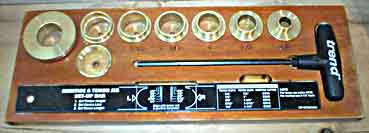Observations after playing with this jig for a few hours
To preface the following, I've not used this jig in an actual piece yet. But I have made three or four of each of the four tenon types this jig can be used to make
- simple tenon,, (sides parallel to part's faces and edges)
- angled on X axis (sides paralleling part's edges but angled relative to part's faces)
- angled on Y axis (sides parallel to part's faces but angled to the part's edges)
- angled on both X and Y axis (sides of tenon not parallel to part's edges or faces)
(There are seven router guides, their "nut", the set up bar and the allen wrench used for the fence and support plate angles to keep track of with this jig. Misplace the set up bar or the large diameter guide or the "nut" and you're SOL. If you make a home for things and make sure they get home when you're through with them you'll know where to find them when you need them. Just a suggestion.

Like most router jigs that can cut tenons (or dovetails or box/finger joints for that matter), the connection between the set up/ operations and the end result is not as obvious as it is when sawing tenons. With these jigs you are not setting the bit to the layout lines of the tenon but rather to guide/bit combinations or template per the set up instructions.
The fit of the sliding stops is a little sloppy but workable. The finish of all the jig's parts is good though. The "package" provides everything you need to use the jig. A better set of bits, preferable with a 1/2" shank would be nice but the bits supplied work.
The jig concept relies on four critical dimensions
- the constant width of the opening in the top of the jig
- the diameter AND roundness of the router guide
- the diameter of the router bit
- the hole in your router base in which the guides are seated
..being centered on the bit's centerline
The following tables compare the "specifications/nominal values with the actual measured values of three of the four critical dimensions items.
Jig's Top Plate Opening Width
Frac....Nominal........Actual
2 1/8__2.125____2.135- 2.144
The oversized (by 0.010 to 0.019 inches) Plate Opening Width yields a mortise and tenon which does not have parallel sides. Because the mortise and tenon are NOT RECTANGLES the parts WILL ONLY FIT ONE WAY. The oversize is only about 1/64th of an inch, a pass or two with a shoulder plane fixes the problem - but it would be nice to get things right just using the jig.
___Guide Diameter___
Frac.... Nominal.....Actual
2 1/8___ 2.125___ 2.120
1 1/4___1.250___ 1.249
1 3/16__1.1875__ 1.1870
1 1/8___1.125___ 1.124
1______1.000___ 1.000
7/8_____0.875___ 0.874
5/8____ 0.625____0.625
The "2 1/8" guide is used to cut the mortise part of the M& T joint. Being undersized by 0.005 inches it produces a mortise that is 0.010 inches WIDER, regardless of the bit diameter. That's a little over 1/128th of an inch - not a big deal but duly noted.
Bit Diameter
Bit Ref. Frac.. Nominal... Actual
C008__ 1/4___ 0.250___ 0.255
C012__ 5/16__ 0.3125__ 0.320
C015__ 3/8___ 0.375___ 0.373
C022__ 1/2___ 0.500___ 0.500
C026__ 5/8___ 0.625___ 0.625
Oversized bits produce UNDERSIZED tenons.
Undersized bits produce OVERSIZED tenons.
OK - so much for "data". In actual application the net result is a slightly oversized tenon which is easily fixed with a few passes of a file or piece of 120 grit on a stick or a pass or two with a shoulder plane.
The set up bar markings used to set the end stops could be more precise if Trend extended the alignment lines over the edge of the "set up bar". Not a real big deal if you don't mind a little "adjustment room" in your mortises.
I want to try this jig making loose tenon M & T joints. If it'll cut mortises at angles to either the X axis or Y axis or a combination I'll be one happy camper and the jig will get me doing more M& T joints (and I already have the General International 75-075 M1 tilting head mortiser with and XY table, which will then be used only for through M & T joints)
Would I buy this jig again? At $275 US for the jig, guides and router bits the anwer is yes. At $375 for just the jig, another $20-$30 for guides and another $30-$40 for the router bits - well I'd have to think twice but I'd probably fork over the money. Is this a precision jig like the Leigh FMT that goes for over $700 for the basics and can get up in the $850 - $950 range "loaded"? No. The set up doesn't have a cross hairs, there's no special plate you have to fix your router to and no sets of precision jig guides to keep track of. There's also no 200 page user's manual with lots of clear illustrations and diagrams - in color. But this jig works pretty well - at about half the retail price and 1/3rd the price at the show package price.